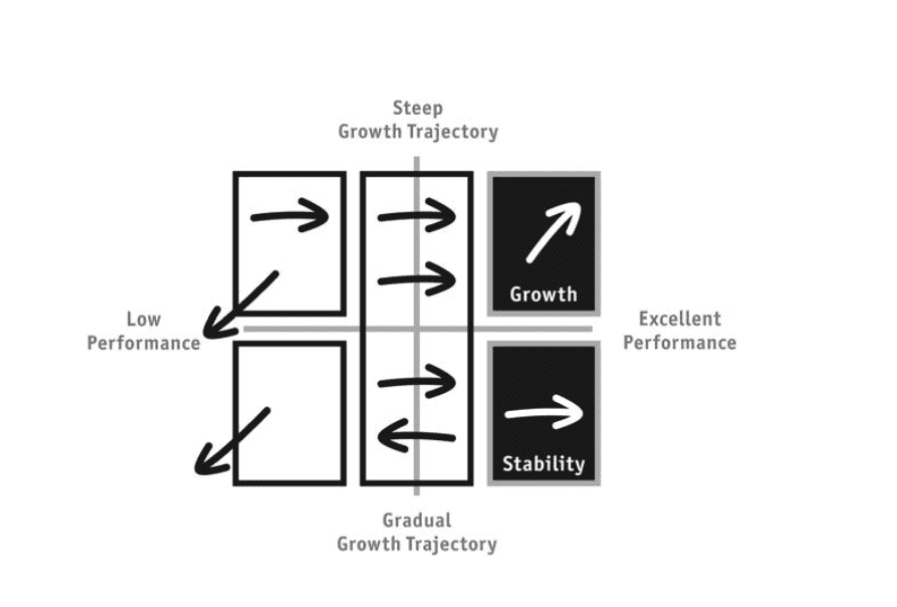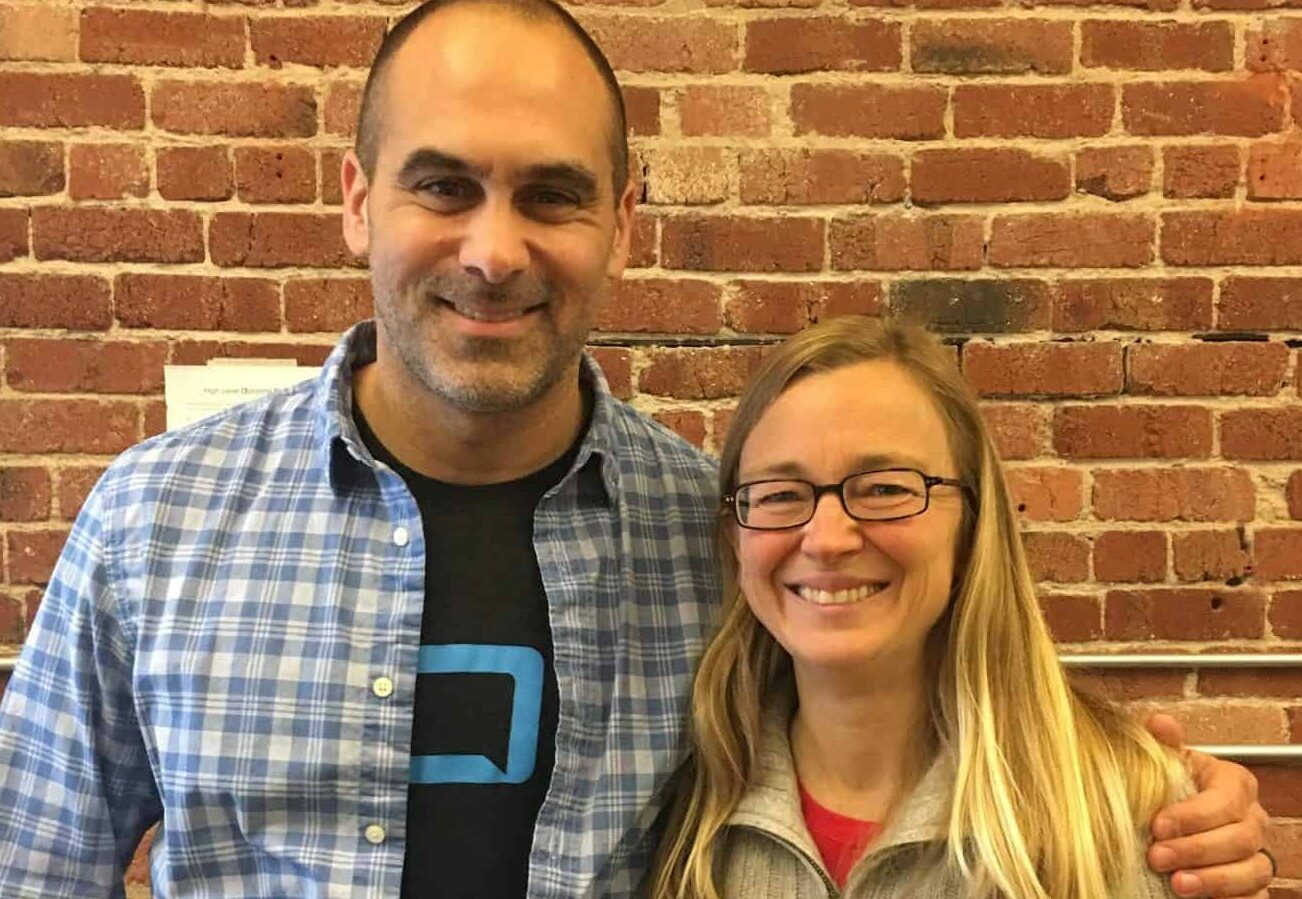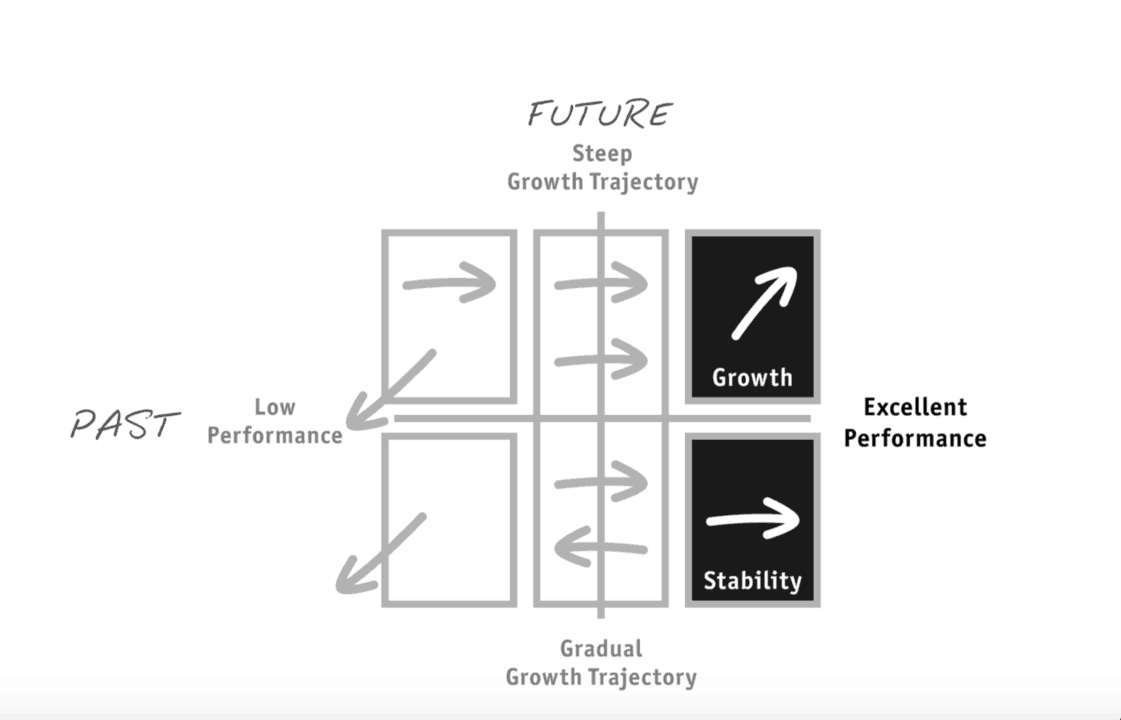5 Reasons People On Steep Growth Trajectories Are Underperforming (and What to Do About it)
*This article about underperforming employees while on a steep growth trajectory has been adapted from Radical Candor: Be a Kickass Boss Without...
9 min read
Kim Scott Jan 9, 2023 12:20:03 AM

This post about balancing team growth and stability is an adapted excerpt from Radical Candor: Be a Kickass Boss Without Losing Your Humanity. Get bulk book discounts for teams and download our reading guide to test your knowledge of the concepts as you go.
In order to build and sustain a great team, you need to understand how each person’s job fits into their life goals. You need to get to know each person who reports directly to you, to have real, human relationships — relationships that change as people change.
When putting the right people in the right roles on your team, you’ll also have to challenge people in a way that will impact not just their feelings but also their income, their career growth, and their ability to get what they want out of life.
Building a team is hard. But as we’re seeing now during the Great Resignation, failure to spend time building and investing in team growth and stability can have disastrous consequences. According to research from Gallup, “One of the most disruption-proof, time-tested human needs is for development. People demand growth and development.” And in order to be successful, this means developing people on both steep and gradual growth trajectories.
A leader at Apple had a good way of thinking about different types of ambitions that people on her team had so that she could be thoughtful about what roles to put people in.
To keep a team cohesive, you need people who are in rock-star mode and superstar mode, she explained. People in rock-star mode are solid as a rock and they are the backbone of team stability. Think the Rock of Gibraltar, not Bruce Springsteen. They love their work. They have found their groove. They don’t want the next job if it will take them away from their craft.
Not all artists want to own a gallery; in fact, most don’t. If you honor and reward the people in rock-star mode, they’ll become the people you most rely on. If you promote them into roles they don’t want or aren’t suited for, however, you’ll lose them — or, even worse, wind up firing them.
People in superstar mode, on the other hand, need to be challenged and given new opportunities to grow constantly. They are the catalysts for team growth.
In order to distinguish between the two, you must let go of your judgments and your own ambitions, forget for a while what you need from people, and focus on getting to know each person as a human being.
For many bosses, this means rethinking ambition. If I say a person is “ambitious,” do you have a positive or a negative reaction? Do you assume the person is hell-bent on personal gain and slightly sinister, willing to trample others to achieve personal goals?
Or do you assume that the person is responsible and gets things done, a force for positive change in the larger group?
If I say a person is “stable,” what is your “blink” reaction? That the person is a snooze whom you’d rather not sit next to at a dinner party? Or do you get a sense of relief and comfort and think that this is the sort of person you’d like to have more of in your life?
If I say a person is “content,” what is your reaction? Do you admire that person? Would you like to be more that way yourself? Or do you assume this is someone who is going nowhere?
Now, let go of all these reactions and judgments. Look at the following two columns of words and think about positive examples of people you’ve worked with who would fall into each column.
Think about teams you’ve worked on that have needed some of each and what the right ratio would be. Then think about times in your life when you’ve been in each of the columns and why. Ideally, the choice would have been yours and not your boss’s.
There’s a story about a boss on a steep growth trajectory — me — who insisted that everybody share my ambitions, and how my experiences at Apple set me straight.
Unfortunately, for too long I believed that pushing everybody to grow super-fast was simply “best practice” for building a high-performing team.
I was always looking for the best, the brightest, the brashest, and the most ambitious. For the first 20 years of my career, it never occurred to me that some people did not want the next, bigger job.
When I designed Managing at Apple, an early iteration of the class encouraged managers to focus the lion’s share of attention and resources on the most ambitious people on their teams, often to the detriment of people doing equally good work and happy to keep doing it — the backbone of a strong team.
And, ironically, the kind of person I had become at that stage in my career. Scott Forstall, who built the iOS team and worked directly for Steve Jobs, helped me understand that this approach was profoundly out of step with Apple’s ethos — and, moreover, that it didn’t create the optimal team.
We were discussing the performance-potential matrix that so many companies use for succession planning or “talent management.” McKinsey & Company originally developed it to help General Electric decide which businesses to invest in, and HR departments at thousands of organizations have adapted it for talent management.
This matrix asks managers to assess both the performance and the potential of all employees and then put them into one of nine boxes — “high performance/high potential” being the best and “low performance/ low potential” being the worst.
“‘Potential’ doesn’t seem like the right word,” I said. “I don’t think there is any such thing as a low-potential human being.”
There was an idealistic side to my hard-charging approach to team-building.
“Words matter,” Scott said. “Let’s wrestle with it.” We debated it for some time. One problem with the “potential” category was that it didn’t seem to allow for a positive evaluation of people who were great at what they did and wanted to keep doing it.
Scott needed to keep people like that happy and productive, and he expected all the managers in his organization to do the same. Scott proposed using the word “growth” instead of “potential,” to help managers think about what opportunities to give to which people on their teams.
Changing one word made a world of difference. Instead of asking an implicitly judgmental question like, “Is this a person with high or low potential?” We encouraged managers to ask themselves questions like, “What growth trajectory does each person on my team want to be on right now?” or “Have I given everybody opportunities that are in line with what they really want?” or “What growth trajectory do my direct reports believe they are on?"
Do I agree? And if I don’t, why don’t I?” Sometimes people really want to grow and are capable of contributing more than they have been allowed to; at other times, they simply want more money or recognition but don’t really want to change the way they work or contribute any more than they do already.
As the boss, you’re the one who’s going to have to know your direct reports well enough to make these distinctions and then have some Radically Candid conversations when you see things differently.
This set of questions around growth trajectory can help you discover what motivates each person much better than a set of questions around “potential” or “talent” could. And the insights it produces will help you avoid burning out folks in rock-star mode and boring those who are in superstar mode.
These questions will help remind you that trajectories change and that you shouldn’t put permanent labels on people. They will help you create team stability stable that achieve astounding results. Scott was right. Words matter.
Shifting from a traditional “talent management” mindset to one of “growth management” will help you make sure everyone on your team is moving in the direction of their dreams, ensuring that your team collectively improves over time. Creativity flourishes, efficiency improves, people enjoy working together.
You can use this “growth management” framework to clarify your thinking about how to manage the two different types of high performers — those on a steep growth trajectory and those on a more gradual growth trajectory — differently.
It will remind you to help people conduct their careers in the way they desire, not in the way you think they should want to. You can also use it to remember to push everyone on a team toward excellent performance, as well as to figure out whom to hire, whom to fire, and when a person’s poor performance might just be the boss’s (your) fault.
The most important thing you can do for your team collectively is to understand what growth trajectory each person wants to be on at a given time and whether that matches the needs and opportunities of the team.
To do that, you are going to have to get to know each of your direct reports at a personal level. It’s also going to require you to have some of the hardest conversations you’ll ever have. Sometimes, you’ll even have to fire people.
The axes of this framework are past performance and future growth trajectories. The assessment of past performance on the horizontal axis of this framework does go from “bad” to “good,” but not the vertical axis. It’s just as good to be in the bottom-right quadrant as in the upper-right.
People in rock-star mode are just as important to a team’s performance as people in superstar mode. Stability is just as important as growth — think of all of the organizations suffering during the Great Resignation because they didn’t nurture their employees’ growth. The right mix of each will change over time, but you’ll always need some of each.
When assessing a person’s past performance, it’s useful to consider both their results and more intangible things like “teamwork.” The expected results for a given quarter or year are ideally set by the employee; they should be as objective and as measurable as possible.
The intangibles are usually impossible to measure but not too hard to describe, and so expectations should be clear here as well.
Performance is not a permanent label. No person is always an “excellent performer.” They just performed excellently last quarter. The past is much easier to understand than the future.
The future is best described by each person’s current “growth trajectory.” Before considering how to manage each type of employee to ensure your team is cohesive, it’s worth taking a little more time to understand exactly what I mean by “growth trajectory,” and why it matters so much.
To be successful at growth management, you need to find out what motivates each person on your team. You also need to learn what each person’s long-term ambitions are, and understand how their current circumstances fit into their motivations and their life goals.
Only when you get to know your direct reports well enough to know why they care about their work, what they hope to get out of their careers, and where they are in the present moment in time can you put the right people in the right roles and assign the right projects to the right people. (For a specific technique, see our post on Career Conversations.)
“Steep growth” is generally characterized by rapid change — learning new skills or deepening existing ones quickly. It’s not about becoming a manager — plenty of individual contributors remain on a steep growth trajectory their entire careers, and plenty of managers are on a gradual growth trajectory.
Nor should steep growth be thought of as narrowly as “promotion.” It’s about having an increased impact over time.
Gradual growth is characterized by stability. People on a gradual growth trajectory, who perform well, have generally mastered their work and are making incremental rather than sudden, dramatic improvements.
Some roles may be better suited to a person in rock-star mode because they require steadiness, accumulated knowledge, and attention to detail that someone in a superstar mode phase might not have the focus or patience for.
People in a superstar mode phase are bad at rock star roles, and people in a rock star phase will hate a superstar role.
Most people shift between a steep growth trajectory and a gradual growth trajectory in different phases of their lives and careers, so it’s important not to put a permanent label on people.
For example, there were two aspiring Olympic athletes on my team at Google. Both women did great work, but right out of college, when they were at their athletic prime, they poured as much energy into training as into work.
They were on a gradual growth trajectory at work, a steep growth trajectory in sports. Five years later, both pivoted, pouring all that drive and energy into their careers rather than into sports. Their career trajectories rocketed.
Of course, most of us aren’t aspiring Olympic athletes. I certainly am not. There are lots of reasons why people shift between a gradual and a steep growth trajectory, and circumstances that spur one person to do one thing spur another person to do the opposite.
Take having a child. Sometimes the financial burden of parenthood spurs ambition; sometimes the desire to get home in time to play with young children spurs a desire for more predictability.
Sometimes an ill relative requires a person to get on a more gradual growth trajectory but, when the illness passes, ambition kicks back in. Generally, an ambition or a commitment outside of work enhances a person’s value to the team — that means you get, say, a great artist as your graphic designer, as long as you don’t insist that the artist get on the fast track at work.
This post has been excerpted from Radical Candor: Be a Kickass Boss Without Losing Your Humanity. Get bulk book discounts for teams and download our reading guide to test your knowledge of the concepts as you go.
————————————————————————————————————————————————————————————–
Need help practicing Radical Candor? Then you need The Feedback Loop (think Groundhog Day meets The Office), a 5-episode workplace comedy series starring David Alan Grier that brings to life Radical Candor’s simple framework for navigating candid conversations.
You’ll get an hour of hilarious content about a team whose feedback fails are costing them business; improv-inspired exercises to teach everyone the skills they need to work better together, and after-episode action plans you can put into practice immediately to up your helpful feedback EQ.
We’re offering Radical Candor readers 10% off the self-paced e-course. Follow this link and enter the promo code FEEDBACK at checkout.

*This article about underperforming employees while on a steep growth trajectory has been adapted from Radical Candor: Be a Kickass Boss Without...

Helping each person on your team grow in the direction of their dreams is part of being a kick-ass boss, and it's the key to successful growth...

I recently learned that my great-grandfather Taylor Malone started a company with my husband’s great-great uncle, Joe Hyde, in Memphis, Tenn., my...